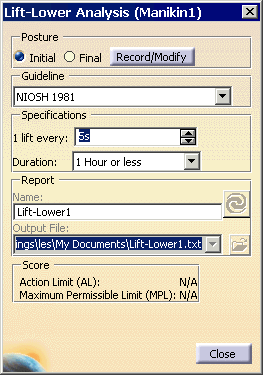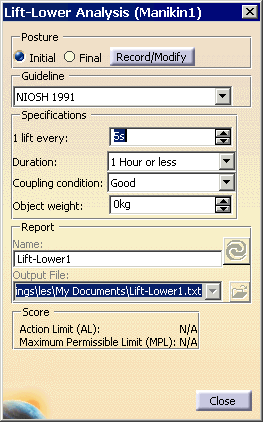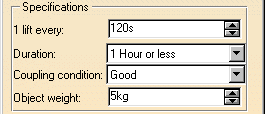 |
-
Select the Lift-Lower Analysis
 from the Ergonomic Tools toolbar. The Lift-Lower Analysis
dialog box
appears when the Manikin is selected. Depending on the Selected Guideline,
the dialog box changes. With the manikin in the first position, select
the Initial button, and the Record bar.
from the Ergonomic Tools toolbar. The Lift-Lower Analysis
dialog box
appears when the Manikin is selected. Depending on the Selected Guideline,
the dialog box changes. With the manikin in the first position, select
the Initial button, and the Record bar.

-
Move the manikin to the
second position that is to be analyzed, and select the Final button, and
select the Record bar.
After the Lift-Lower analysis
is completed, the Score and Warning are shown.

-
The dialog box for NIOSH
1991.

The fields to choose from are:
| Posture |

This area of the dialog box has two functions:
- Display and choose postures (Initial and Final toggle buttons)
Use these two toggle buttons to select which posture you want to
record or modify. When the postures are recorded, use these buttons to
switch back and forth between the two postures. The manikin in the scene
displays the current posture selected.
- Record or modify the selected posture (Record/Modify push button)
Use this push button to record a posture. Use the Initial and Final
buttons to select the posture to be recorded. If the manikin's current
posture does not respect the lifting task definition, an error message
will be displayed with the list of the missing or bad prerequisites.
|
|
| Guideline |
From this list, select the guideline to perform the lift-lower analysis.
The guidelines available are NIOSH 1981, NIOSH 1991, and Snook & Ciriello. The Specifications and Scores will change depending on which guideline
is chosen.

| NIOSH
1981 |

Specifications
- 1 lift every:
Use this specification to determine lift frequency. Click on the
arrows to increase or decrease the value indicated in the text field or
directly enter a new value using the keyboard.
- Duration:
Use this field to enter the duration of the work in hours per day. The
work is considered:
- occasional if the value is one hour or less
- continuous if the value is 8 hours

Score
Immediately after the frequency and duration fields are completed, the
results are displayed in the Score zone.
- Action Limit (AL):
This value represents the weight below which the task could be
considered as reasonably safe.
- Maximum Permissible Limit (MPL):
This value represents a limit above which the lifting task is
considered as hazardous and requires engineering controls.
|
| NIOSH
1991 |

Specifications
- 1 lift every:
Use this specification to determine lift frequency. Click on the
arrows to increase or decrease the value indicated in the text field or
directly enter a new value using the keyboard.
- Duration:
Use this field to enter the duration of the work in hours per day. The
work is considered:
- occasional if the value is one hour or less
- continuous if the value is 8 hours
- Coupling condition:
Use this function to quantify the quality of the hand-to-object. The
coupling quality is classified as Good, Fair, and Poor.
- Good - a comfortable grip in which the hand can easily wrap around
the object
- Fair - a grip in which the hand can be flexed about 90 degrees.
- Poor - when the the object is hard to handle (irregular, bulky,
sharp edges, etc.)
- Object weight:
Use this field to enter the load weight. This value is used for the
lifting index calculation.

Score
Immediately after the frequency and duration fields are completed, the
results are displayed in the Score zone.
- Origin
This result is based on the initial posture of the manikin.
- Recommended Weight Limit:
The RWL is the load weight that healthy workers can lift over a certain
period of time without risk.
- Lifting Index:
The LI provides a relative estimate of the level of physical stress.
- Destination
This result is based on the final posture of the manikin.
- Recommended Weight Limit:
The RWL is the load weight that healthy workers can lift without risk.
- Lifting Index:
The LI provides a relative estimate of the level of physical stress.
This will allow you to easily view the various multipliers
(intermediate results) that are used in the NIOSH 1991 Lifting
Equation, and to copy/paste them in another text editor, for future
reference. The goal here is to provide more pertinent
information.
To attain these results of recommended weight limit and lifting
index from the manikin posture, we use the equations prescribed in
the literature regarding the NIOSH 1991 study. The
text below presents these equations.
But because these factors carry substantial information on their
own, and because this information is supplemental to the
information given by the final output (WRL and LI),
there is a need to display these values as well. This way, you can be fully informed of a particular factor change,
say the frequency multiplier, and can appreciate precisely how any
of the intermediate factors influences the final result.
The following two equations are taken verbatim from the
brochure entitled:
"Applications Manual for the Revised NIOSH Lifting
Equation", U.S. Department of Health and Human Services,
Cincinnati, Ohio, January 1994:
RWL = LC * HM * VM * DM * AM * FM * CM
L
LI = ____
RWL
Here, we see that a few intermediate variables
("LC", "HM", and so on) are needed, and calculated
internally, in order to produce the two main results of the
analysis. These variables are:
- A load constant (LC)
- The horizontal multiplier (HM)
- The vertical multiplier (VM)
- The distance multiplier (DM)
- The asymmetric multiplier (AM)
- The frequency multiplier (FM)
- The coupling multiplier (CM)
- The load weight carried by the subject
(L)
This way, you can be fully informed of a particular factor
change, say the frequency multiplier, and can appreciate
precisely how any of the intermediate factors influences
the final result.
As this lack of information prevents
you from
understanding how the analysis operates.
|
|
|
Snook & Cirielloo
|

Specifications
- 1 lift every:
Use this specification to determine lift frequency. Click on the
arrows to increase or decrease the value indicated in the text field or
directly enter a new value using the keyboard.
- Population sample:
Three population percentiles are provided: 90th, 75th, and 50th. These
percentiles represent the percentage of the population able to perform
the task safely. The selected percentile takes the manikin gender into
account.

Score
Immediately after the frequency and population sample fields are
completed, the results are displayed in the Score zone.
- Maximum Acceptable Weight:
The maximum acceptable weight is defined as the weight that the
selected population can handle with reasonable safety.
|
|
| Report |
See
Reporting Capabilities
|
|
 from the Ergonomic Tools toolbar. The Lift-Lower Analysis
dialog box
appears when the Manikin is selected. Depending on the Selected Guideline,
the dialog box changes. With the manikin in the first position, select
the Initial button, and the Record bar.
from the Ergonomic Tools toolbar. The Lift-Lower Analysis
dialog box
appears when the Manikin is selected. Depending on the Selected Guideline,
the dialog box changes. With the manikin in the first position, select
the Initial button, and the Record bar.






